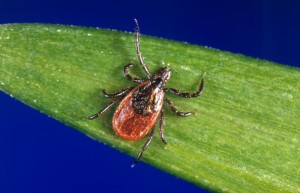New York: Powassan virus confirmed in two Putnam County residents
Two people in the in the lower Hudson River Valley county of Putnam have been confirmed positive for the tick borne illness, Powassan (POWV) virus, according to county health officials.
Health officials report the two patients are recovering at home.

Ixodes scapularis
Image/CDC
Between 2001 and 2012, POWV neuroinvasive disease cases have been reported in Maine (2), Michigan (1), Minnesota (19), New York (13), Pennsylvania (1), Virginia (1), and Wisconsin (10). These cases occur primarily in the late spring, early summer, and mid-fall when ticks are most active.
POW virus, like Lyme disease, is transmitted through the bite of an infected deer (black-legged) tick. The POW virus can be transmitted in as little as 15 minutes; in contrast, most Lyme infections require the tick be attached for at least 36 to 48 hours before the bacterium can be transmitted, according to the Putnam County Health Department.
Signs and symptoms of POWV infection can include fever, headache, vomiting, weakness, confusion, seizures, and memory loss. Long-term neurologic problems may occur. People with severe POW virus illness often need to be hospitalized to receive respiratory support, intravenous fluids, or medications to reduce swelling in the brain that may occur.
There are 2 types of POWV in the United States. The 1st type, often called lineage 1 POWV , appears to be associated with Ixodes cookei or Ixodes marxiticks. The other type, lineage 2 POWV is sometimes called Deer tick virus, and is associated with Ixodes scapularis ticks. Both lineages have been linked to human disease. Humans become infected with POWV from the bite of an infected tick. Humans do not develop high enough concentrations of POWV in their bloodstreams to infect feeding ticks. Humans are, therefore, considered to be “dead-end” hosts of the virus.
“Preventing tick bites is the first defense in preventing all tick-borne infections,” said Allen Beals, M.D., Commissioner of Health, “but especially important given the rapid transmission of the POW virus. This illness gives another reason to seriously consider applying a repellent containing DEET, which has been highly effective in preventing bites.”
People who frequent wooded and tall, grassy areas, such as hunters, campers, hikers, gardeners, and outdoor workers, are more likely to be exposed to ticks. The deer tick cannot fly or jump, but instead rests on low-lying vegetation and attaches to passing animals and people. The risk is greatest along trails in the woods and on the edges of properties with tall vegetation, where the higher humidity levels are ideal for tick survival. However, ticks are also carried into lawns and gardens by pets, mice and other small animals.
Decrease your chances of a tick bite by taking the following precautions:
- Tuck pants into socks and shirt into pants when in wooded and grassy areas.
- Wear light-colored clothing to spot ticks more easily.
- Check for ticks on clothing or skin frequently. Brush them off before they can attach to your skin.
- Do a thorough “tick check” of your entire body daily. Pay particular attention to the back of the knees, behind the ears, the scalp, the armpits and your back.
- Repellents containing DEET have been effective in preventing tick bites. If you decide to use a tick repellent, apply carefully and follow all label directions. Bathe or shower and change clothes when you go back inside.
- Do not apply repellents directly to children. Apply to your hands and then transfer it to the child. Never apply repellents to children’s hands or face.
- No one should apply repellents near eyes, nose or mouth.
If an attached tick is found, remove it immediately. The Health Department recommends the following method: (1) Use fine-tipped tweezers to carefully grasp the mouth-parts—not the body—of the tick, close to the skin. (2) Gently and steadily pull the tick out without twisting or squeezing. (3) Wash the bite area thoroughly. (4) Apply antiseptic.
For more infectious disease news and information, visit and “like” the Infectious Disease News Facebook page















This article needs some more facts added. The Powassan Virus is only one of many Co-infections of Lyme, however, it’s one that has caused instant death like the Burbon and Heartland Virus…the other Co-infections may not kill like those…but still are life changers. One Victim lost ALL her limbs…but remember folks..it’s no big deal… cuz CDC=Center Disease CONTROL and PREVENTING 24/7 Saving lives Protecting people has had this under corrupt control for Decades! It seems all these articles like to have #’s…..so lets keep CDC’s # of 300,000 people WILL become infected EACH YEAR world wide…Are you sitting down? Well, here in New York on a small road going no-where….a sheet drag got over 100 ticks…take that and Multiply that by either 3k or 30k eggs that ticks lay…..OUCH!!….that’s over the CDC#’s worldwide just on one street in New York….OUCH….yet we don’t have an epidemic? It’s sexually transmited and in the organblood supply….still we don’t have a problem here?